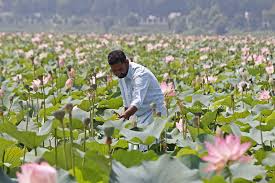Lotus blooms in Kashmir’s Wular lake after 30 years: ‘Thought we lost god’s gift forever’

In a stunning turn of events, Kashmir’s Wular Lake has once again come alive with the vibrant hues of lotus flowers—an ecological and cultural marvel that locals thought had disappeared forever. After a 30-year absence, the sudden bloom has rekindled memories, inspired hope, and brought attention back to one of Asia’s largest freshwater lakes.
Wular Lake, located in the Bandipora district of Jammu and Kashmir, has long been an emblem of Kashmir’s natural beauty. But over the last few decades, the lake had fallen victim to pollution, unregulated development, and environmental neglect. Among the many signs of its ecological deterioration was the loss of its famed lotus bloom—a flower revered not just for its beauty, but for its cultural and spiritual symbolism.
A Bloom the Valley Had Forgotten
For the older generation in Bandipora, the reappearance of the lotus is nothing short of a miracle.
“I remember going out with my grandmother to pluck lotuses for cooking and making garlands,” recalls 60-year-old Shakeela Begum. “That tradition ended years ago. I never thought I’d see them again in my lifetime.”
Locals had almost given up hope. The floating gardens once dominated the lake’s surface, but slowly disappeared as silt and invasive species choked the lakebed. Now, after a long absence, those same waters are dotted with soft pink petals, drawing curious onlookers from across the region.
The Science Behind the Surprise
Experts believe the bloom may be the result of a unique mix of natural and human-led factors. Over the last two years, the Wular Conservation and Management Authority (WUCMA) intensified its efforts to clean and restore the lake. De-siltation drives, the removal of illegal constructions, and stricter monitoring of waste dumping have played a significant role in reviving Wular’s aquatic ecosystem.
“While we are still studying the phenomenon, the bloom likely emerged from dormant tubers lying beneath the silt,” explains Dr. Irfan Majeed, an environmental scientist at the University of Kashmir. “This year’s unusual climatic conditions—low snow, moderate rainfall, and higher early summer temperatures—may have triggered the growth.”
The reappearance of the lotus, he says, indicates improving water quality and a partial recovery of the lake’s ecological balance.
A Cultural Reawakening
In Kashmir, the lotus (Nadru in local parlance) is more than just a flower. It’s deeply embedded in the region’s cuisine, traditions, and even poetry. Its return has led to a quiet cultural revival. Women have resumed the ancient craft of weaving lotus stems into mats and baskets. Local markets are once again seeing small batches of lotus stems being sold for traditional dishes.
Children, who have only heard about the blooms from their elders, are seeing them for the first time in real life. “We used to read about lotus flowers in books,” says 12-year-old Amaan from Watlab village. “Now we’re seeing them in front of our eyes.”
For the residents, the moment is more than a sight—it’s a feeling.
“It feels like the lake is smiling again,” says fisherman Ghulam Nabi. “It’s like getting back something sacred we thought we had lost.”
A Boost to Eco-Tourism?
The scenic return of lotus blooms has also sparked interest among tourists and photographers. Social media is already flooded with images of the lake blanketed in pink blossoms, and the Jammu & Kashmir tourism department has taken note.
Plans are underway to promote responsible eco-tourism in the area.
“We’re considering guided boat tours during the blooming season, with strict guidelines to prevent damage to the ecosystem,” said a tourism official. “The lotus bloom can be a powerful symbol to draw visitors, but we have to make sure we protect what we have regained.”
WUCMA has installed informational boards, and volunteers are educating visitors about the importance of preserving the lake’s biodiversity.
The Challenges Remain
Despite the joy surrounding the bloom, environmentalists are quick to warn that one good season doesn’t signal a full recovery. Wular Lake still faces serious long-term threats. Urban waste, shrinking wetlands, overfishing, and illegal constructions continue to challenge conservation efforts.
“This bloom is a wake-up call, not just a celebration,” says Dr. Majeed. “If we want the lotus to stay, we must act now—consistently and collectively.”
There’s also concern about over-harvesting. As the demand for lotus stems and seeds picks up, authorities are cautioning locals not to disturb the fragile growth. Harvesting guidelines are being drafted to ensure the bloom isn’t cut short due to human greed.
A Symbol of Resilience
In many cultures, the lotus symbolizes rebirth and purity—growing from murky waters yet blooming beautifully. For the people of Kashmir, that symbolism is now more personal than ever. The return of the lotus has not just added color to the lake but also to the hearts of those who live around it.
“It reminds us that nature heals, sometimes quietly and slowly,” says Zahra Wani, a schoolteacher who has been writing poetry inspired by the bloom. “We must give it the space and respect it deserves.”






